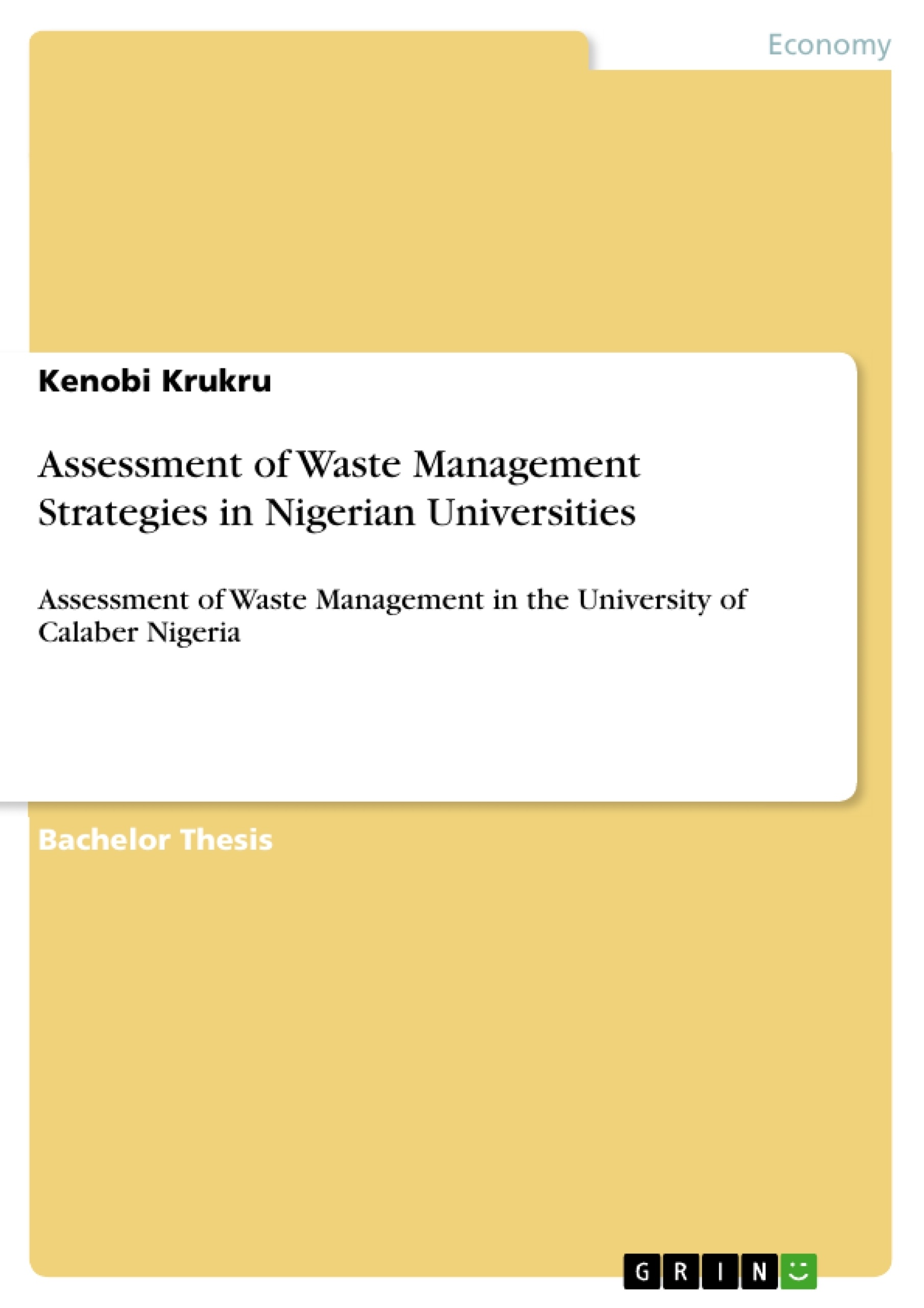This study was undertaken to assess the management strategies of solid waste in the University of Calabar. In order to guide the study, 6 objectives were identified and one hypothesis formulated. Several literatures were reviewed and data was collected through structured questionnaires. Collected data was analyzed using the Pearson product moment correlation and the student t-test.
Findings revealed that there is efficient waste management in the University of Calabar. Meaningful recommendations were suggested to create awareness of the need for a clean environment for man’s habitation.
Inhaltsverzeichnis (Table of Contents)
- CHAPTER ONE INTRODUCTION
- 1.1 Background of study...
- 1.2 Statement of the problem.
- 1.3 Aims and objectives of study...
- 1.4 Significance of the study
- 1.5 Research hypothesis.......
- 1.6 Study area
- 1.7 Scope of study.
- CHAPTER TWO REVIEW OF RELATED LITERATURE.
- 2.1 Introduction........
- 2.2 Conceptual framework...
- 2.3 Methods of solid waste management in the University of Calabar.
- 2.4 Problems of waste management in the University of Calabar....
- CHAPTER THREE METHODOLOGY OF STUDY
- 3.1 Introduction.......
- 3.2 Types of data.
- 3.3 Sources of data
- 3.3.1 Primary data
- 3.3.2 Secondary data.
- 3.4 Sampling technique.
- 3.5 Population of study.
- 3.6 Research design..
- 3.7 Instrumentation
- 3.8 Procedure for data collection.........
- 3.9 Procedure for data analysis.......
- CHAPTER FOUR DATA ANALYSIS, PRESENTATION AND INTERPRETATION
- 4.1 Introduction.......
- 4.2 Presentation of data.
- 4.3 Test of hypothesis.
- 4.4 Interpretation of results.
- CHAPTER FIVE SUMMARY, CONCLUSION AND RECOMMENDATION
- 5.1 Summary......…………………
Zielsetzung und Themenschwerpunkte (Objectives and Key Themes)
The study aims to assess the management strategies of solid waste in the University of Calabar. This is achieved through a review of relevant literature, data collection using structured questionnaires, and data analysis using statistical techniques. The study is guided by a series of objectives and a formulated hypothesis.
- Efficient waste management practices in the University of Calabar
- Methods and challenges associated with solid waste management in the institution
- The impact of waste management practices on the environment and human health
- Recommendations for improving waste management strategies and promoting environmental sustainability
Zusammenfassung der Kapitel (Chapter Summaries)
Chapter One: Introduction presents the background of the study, outlining the significance of waste management in the University of Calabar. It also states the problem, aims, and objectives of the study, along with the research hypothesis, study area, and scope of the investigation.
Chapter Two: Review of Related Literature provides an overview of the existing literature on waste management, focusing on the conceptual framework, methods of solid waste management in the University of Calabar, and the problems associated with waste management in the institution.
Chapter Three: Methodology of Study details the research methods employed in the study. This includes the types and sources of data used, the sampling technique, population of study, research design, instrumentation, and procedures for data collection and analysis.
Chapter Four: Data Analysis, Presentation, and Interpretation presents the findings of the study through data analysis, presentation, and interpretation of the results. This chapter includes testing of the formulated hypothesis.
Schlüsselwörter (Keywords)
Solid Waste Management, University of Calabar, Environmental Sustainability, Waste Management Strategies, Waste Collection, Waste Disposal, Waste Reduction, Environmental Impact, Health Impact, Questionnaire Survey.
- Citar trabajo
- Kenobi Krukru (Autor), 2015, Assessment of Waste Management Strategies in Nigerian Universities, Múnich, GRIN Verlag, https://www.grin.com/document/337207



